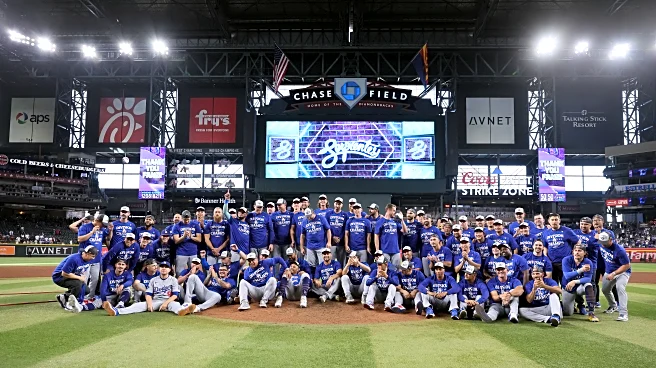What's Happening?
The Los Angeles Dodgers secured a victory against the Cincinnati Reds with an 8-4 win, advancing to the National League Division Series (NLDS) where they will face the Philadelphia Phillies. Yoshinobu Yamamoto delivered an impressive performance, striking out nine batters over 6.2 innings. Mookie Betts contributed significantly with four hits and three RBIs. Meanwhile, Clayton Kershaw's status for the NLDS has been confirmed by manager Dave Roberts, following his absence from the Wild Card roster. Additionally, Tommy Edman was absent from the lineup due to an ankle injury sustained towards the end of the regular season, which led to his removal from center field to minimize strain.
Why It's Important?
The Dodgers' advancement to the NLDS is a crucial step in their postseason journey, highlighting their strong performance and strategic management. Clayton Kershaw's potential return could bolster the team's pitching lineup, providing a veteran presence and experience. Tommy Edman's injury poses a challenge, as his versatility is valuable to the team's dynamics. The Dodgers' ability to adapt and overcome these hurdles will be pivotal in their quest for a championship, impacting their strategy and lineup decisions moving forward.
What's Next?
The Dodgers will prepare to face the Philadelphia Phillies in the NLDS, with strategic adjustments likely to accommodate Clayton Kershaw's return and manage Tommy Edman's injury. Manager Dave Roberts will need to make critical decisions regarding the pitching rotation and lineup to optimize performance against the Phillies. The team's focus will be on maintaining momentum and addressing any weaknesses exposed during the Wild Card series.
Beyond the Headlines
The Dodgers' postseason performance underscores the importance of depth and adaptability in a team's roster. The handling of injuries and player rotations reflects broader strategic considerations that can influence a team's success. The decisions made by the management could set precedents for future postseason strategies, emphasizing the balance between veteran experience and emerging talent.











